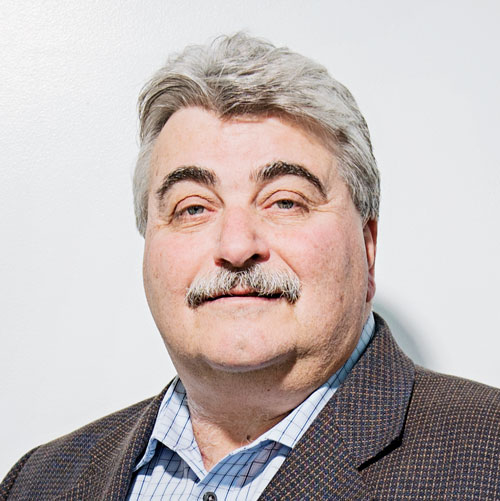
“I knew this was the right building the moment I saw it.” So says Jay Bapna, talking about 5 Giralda Farms, where the bold biopharmaceutical firm Allergan moved its New Jersey colleagues late last year.
Allergan needed a new office in order to bring together colleagues and establish its administrative headquarters in New Jersey. Numerous acquisitions had left its staff working in different offices throughout the state. “We had to decide whether we wanted to continue renewing multiple leases or actually find a new location,” Bapna says. He was serving as the senior vice president of global engineering when Allergan’s leadership decided that it was time to bring everyone under one roof.
By bringing together most of its New Jersey employees in one place, Bapna says, Allergan could unify its teams and focus on “a single, bold culture.” This also meant having a building that was the company’s and only the company’s. “That way, it’s our choice how we manage it, what we do, what kind of culture, branding, and amenities we want to have,” he explains. Furthermore, having the majority of the staff in a single location would increase the opportunity for chance encounters. No longer would relationships be confined to email threads and telephone calls; instead, decisions would be made in person and in a collaborative manner.
The tricky part? Allergan made this decision in May 2016 and needed to be moved into its new space by September 2017. Bapna, whose job it was to find the building, had to look for roughly half a million square feet of space near a rail line that could be moved into within the tight timeline. Consider it fate that Bapna found not only the perfect space but also one with history.
Once upon a time, Geraldine Rockefeller Dodge, famed philanthropist and niece of John D. Rockefeller, had her mansion at 5 Giralda Farms. Among countless other things, Bapna praises the building’s beautiful stonework, its tree-spotted surroundings, and the way it catches light from three sides. “Beautiful light and space on a truly beautiful property,” he says. “They don’t make buildings like this anymore.”

Just as nice is its location in idyllic Madison, New Jersey, a town so charming that it’s served as a quaint backdrop to films such as The World According to Garp and The Family Stone.
That said, the interior of the office building needed substantial work. It was designed as an office space in 1990, and it very much looked like it. “It was very old-fashioned,” Bapna says. “Very large offices, not inviting, no glass. We had to completely gut it and update it.” Allergan’s goal was to create a workspace consisting of only 5 percent offices, with the remaining 95 percent open work spaces to help stimulate conversation and collaboration. “We wanted a lot of glass, a lot of visibility,” Bapna explains. “We designed it in a way that allows people to interact.”
Furthermore, Allergan wanted its new office space to feel welcoming in ways both personal and professional. A 2016 NJ.com article on Allergan’s move into the building describes the space as “a neighborhood, rather than just an office space.” A walk through the building shows informal gatherings of colleagues at tables and workstations alike. Some colleagues are sitting, others standing at ergonomic sit-stand desks. It’s easy to see into meeting spaces, giving even closed areas light and transparency. Throughout the space, there are digital boards sharing corporate messages but also whiteboards with messages left by colleagues for one another. The building is also home to a gym, a wellness center, a coffee shop, and what Bapna calls an “absolutely amazing” cafeteria. The feeling is collegiate, but the work being accomplished is focused. “Our Allergan colleagues are bold for life,” Bapna says. “They are focused on delivering treatments that make a difference to patients around the world.”
As a demonstration of Allergan’s commitment to fostering an employee-friendly workspace, Bapna worked with the company’s leaders to have staff weigh in on the design choices. More than 100 employees tested out potential furniture pieces and workplace styles, and their feedback was then used to select and design components to best fit the work need. “As a collaborative process between the employees and designers, it worked out extremely well,” Bapna says.
Bapna and Allergan’s construction team met their deadline and secured a certificate of occupancy by September 2017, just as they had planned. Bapna’s only true source of anxiety throughout the process, he says, was the quick turnaround of such a massive project. “You can’t imagine how many sleepless nights I had,” he says, discussing the physical pile-ups that became a necessity during such a tight period of construction, with electricians, plumbers, and designers often having to bump up against each other while trying to get everything ready. In just eight short months, $120 million of construction work was completed on the building.
Good fortune smiled on so many portions of the project, from the finding of such a perfect site to a smooth transition of 1,500 employees to a strong relationship with the City of Madison. Bapna says the city was the best government body he’s dealt with in his nearly 40-year career. “They were tough,” he says, noting that they required around 300 inspections throughout the process. “But, they made the effort to actually work with our schedule.”
The project marked one of Bapna’s last in his role as senior vice president of global engineering. As of January 1, 2018, he’d transitioned into a role focused on the manufacturing and production of Allergan’s products as its senior vice president of global pharmaceutical manufacturing. But, what a fantastic project to go out on. Of the finished building, he says, “It’s like a dream come true.”
Photos: Garrett Rowland/Gensler


